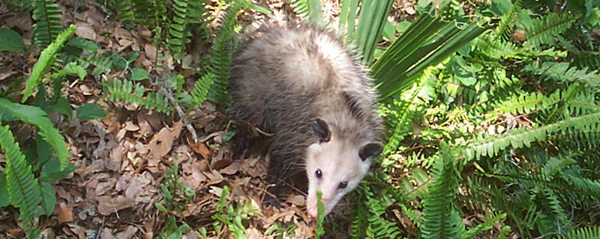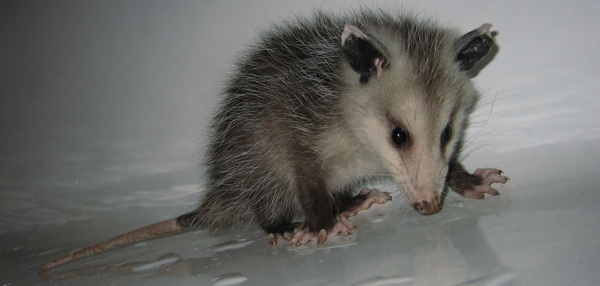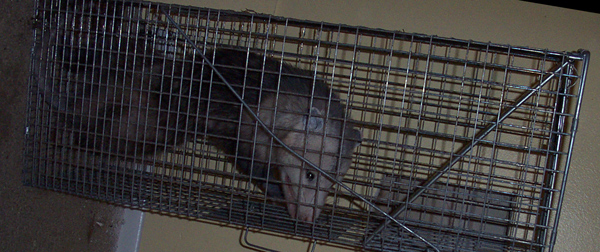- info@wildlife-removal.com
Call us for help in your town
Wildlife Removal Education
Best Ways to Get Rid of Opossums
Need opossum removal in your hometown? We service over 500 USA locations! Click here to hire us in your town and check prices - updated for year 2020.
A lot of people find opossums cute and useful to have around because of how they help to naturally control other house and yard pests like mice, roaches, frogs, and even snakes. They however, tend to wear their welcome out through the gradual damage they cause to structures as well as the constant disturbance of the homeowners’ peace, not to mention their large and stinky droppings! On the flip side too, they are just like other wildlife pests in that they are scavengers who carry parasites that bear diseases like leptospirosis, tuberculosis, relapsing fever, tularemia and spotted fever.

Wildlife trappers and experts have evolved quite a number of methods to solve the problem of nuisance opossums in barns, under decks and sheds, and even in attics.
Exclusion and Prevention
Blocking all of the opossum’s possible access points into your property may be the best bet to keeping it out. You must conduct a detailed inspection of your facilities and carry out all necessary repairs. Block or seal every hole through which possums can crawl inside. It habitually seeks dark and enclosed shelter-like spaces in which to locate its den; places like small garden sheds, and spaces underneath decks or porches.
If your deck or porch is built within two feet of the ground for instance, dig a trench at least 10 inches deep around the deck's perimeter. Attach mesh hardware cloth or welded wire from the top to the bottom of the trench. Leave six to eight inches of wire at the bottom and bend it out at a 90° angle. Fill the trench with soil or rocks. Add lattice or other cover for aesthetics. Another option is to install steel exclusion barriers to keep them out of chimneys, vents, and any opening at all.
Opossum visits can also be prevented by making sure that there is no food for them to eat, as this is the primary attractant for foraging wildlife.
- Keep your yard clean. No eat-out leftovers or litter.
- Don’t leave trashcans and recycling bins outdoors, or if you must, ensure to use animal-proof lids. If possible, keep them indoors or in sealed areas such as a locked shed or outhouse.
- Bring pet food dishes inside at night to avoid attracting wildlife. As long as there is something to eat, they’ll keep visiting.
Live Trapping
There are several types of opossum traps, varying in size and style. They are mostly large steel cages, at least 32x10x12 in dimension and can be bought in stores. Bait the trap with food to lure the animal into the cage. Opossums eat almost anything, but the best baits to use in traps include fish, apples, or canned pet food. Foods with strong smells generally work fine as baits. Bait should be smeared evenly on the trap. The trap should be set in places where you have previously observed opossum activities like burrowing
It is important to study the situation and be sure that the animal you are dealing with is an opossum; confirm too if it is a mother with baby possums, in which case you must get all the babies out as well. Before setting a trap, always check with your local game commission to ensure that trapping is allowed in your area. Also, avoid trapping during early spring and summer to reduce your chances of separating babies and mothers.
After catching an opossum in your trap, you may travel several miles away from your home and release the possum, preferably in the woods.
Opossum Repellents
There are several types of opossum repellents that are available commercially for the purpose of chasing the rat-like mammal away from your yard, but this method is largely ineffective. Opossum repellants basically aim to drive raccoons away from your yard by using its sharp sense of smell against it. The common repellents are predator urine, moth balls, ammonia,
It has been observed that opossums with time, will overcome their aversion for the pungent smell where survival is at stake.
Poison and Lethal Traps
Poisons rarely work for possums and there is none that is legally approved for use. Some of the poisons people use are rat poison, antifreeze, and strychnine. Poisoning is an inhumane and mostly ineffective way to kill any pest as they suffer a lot and may not even die in the end. When they do die, they are likely to do it under a crawl space from where the horrible smell of the carcass permeates the whole area. It’s a no win!
Lethal traps are another inhumane way of removing possums. These traps clamp down on the animal as soon as it is lured in, crushing it to death.
Go back to the Opossum Removal page.
Opossum About
Appearance
Also referred to as Didelphimorphia, the opossum is a medium-sized marsupial that is primarily native to North America. It possesses a white face, long snout, hairless tail, hairy fur, and sharp teeth and claws. The male is often larger and weightier than the female. In America, they are also called possums,

Biology and Life Cycle
After mating, the gestation period of a pregnant opossum lasts for about 12 to 14 days, after which the babies are born and transferred into the pouch. Like other marsupials, the opossum has a pouch (marsupium), in which the female carries new babies around until they are weaned. The mother keeps the helpless kits in her pouch for a period of about 100 days before finally releasing them. Opossums may give birth to 15 or more kits per litter.
Despite their size, marsupials live for a relatively short period of time. Their lifespan ranges from about 2 to 4 years. Opossums are naturally predated by foxes, owls, eagles, dogs and cats.
Habitat
Opossums are native to North America and are naturally found living in wetlands, deciduous forest and grassland. They are arboreal although some can be terrestrial as well. The young ones can hang themselves upside down from trees with their tails, but the tails of the adults are not strong enough to hold them.
Due to deforestation, many opossums have sought abode near humans now. They are found in urban and suburban areas, living under houses, sheds, farmyards and so on.
Diets
Opossums are mainly omnivores; they consume both plants and animals. Their diets differ from subspecies to subspecies – some feed primarily on flesh, others favor plants, and some others feed on plants and animals equally. Their common foods include frogs, earthworms, small mammals, snakes, insects and vegetation.
Behavior
Opossums are nocturnal animals, they are active at night and that is when they forage for food. Even though they often live in burrows, they rarely dig these burrows themselves but would rather inherit the abandoned burrows of other animals.
They are solitary animals and they rarely stay in one place for long periods as they are constantly on the move in search for food.
Opossums are known for their coping feature of pretending when under threat of predation. It has been termed ‘playing possum’ and involves the animal laying still and passing itself off as dead when it senses a serious threat. This trick helps them to escape from predators a lot of times.
Go back to the Opossum Removal page.
How to Remove Opossums Using a One-Way Exclusion Funnel
The use of one-way exclusion funnels is an exclusion strategy that works to get rid of opossums on a property without going through the hassles of trapping and relocation. It is just as humane as removal by trapping is, and unlike trapping, there is no risk of starving the animal due to its being captive.

The way one-way exclusion funnels work, an opossum would be able to get out of a building, but it would be unable to go back inside through it. They can be bought from animal control stores or you may make one for yourself using metal sheets or galvanized wire.
Note the following steps to get good results from using a one-way exclusion funnel:
- The funnel is meant to remove the critter without hurting or killing them. It should be a humane contraption
- Prior to setting it up though, you must ensure that all other openings and potential entry points into the hideout are identified and sealed off.
- Afterwards, place the funnel on the one remaining entry point. Carefully fix the funnel over the mouth of this opening.
- After successfully removing the opossums, proceed to seal off this one remaining opening to guard against re-entry by the critter. If there are any other entry points, block them as well. Use materials like metals that they cannot be chewed through.
This method is particularly good in that and it hardly affects untargeted animals. It poses no major threat to children or pets as they are completely unaffected.
The funnel hole however, must neither be too big nor too small; it should be extremely precise such that an opossum can leave through but find it impossible to get back in. If it's too big, the animal will re-enter easily and if it's too small, it won't be able to go out and the whole essence of using one-way exclusion door becomes defeated.
The proportions of this funnel must be just apt, with the outward opening wide enough to let the opossum out, but not wide enough to let it back in. An experienced hand will get this right. Thus, an untrained individual may not get optimal results from its usage.
Go back to the Opossum Removal page.


















